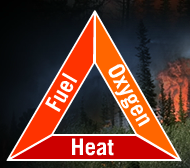Assistant Curator – Wanuskewin Heritage Park
Are you an emerging Indigenous museum professional ready to help share stories that have lived on this land since time immemorial? Wanuskewin Heritage Park invites you to step into a
As a continuation of our summer conservation series, we will be finishing off the final four Agents of Deterioration as defined by the Canadian Conservation Institute (CCI) in Ottawa. If you want to learn more about CCI, see their website or our April 29th blog post.
Fire can have devastating effects on your museum; it destroys collections, buildings, operations, lives, and will. Because of its devastating effects, it is given priority.
Fire requires 3 things to survive:

1. Fuel – this is any combustible material and can include your building, collection, or vegetation.
2. Oxygen
3. Ignition source / Heat – this could be a lightening strike, arson, electrical objects, open flames, or gas leaks.
This image displays these 3 components. Elimination of one of these components eliminates the fire. Image: Smokeybear.com
For a lot of museums, the items listed above as fuel seem like they can be unavoidable. This is true. However, there are certain steps you can take to ensure that the fuel that is the museum or contained in the museum is lessened. Ensure that you have identified objects that contribute considerably to a fuel load, these include muntions, cellulose nitrate film, and flammable liquids. Objects such as these are inherently more susceptible to fire and should be rendered safe for use or stored properly to ensure their contribution to a potential fire is lessened.
Ensure that your buildings are well taken care of; fire prevention systems (detectors, alarms, and suppression) are checked on a regular basis, wiring checked (especially for older buidlings), and use of open flames prohibited. The way that your building is laid out can contribut to fire prevention. If you can eliminate Oxygen, through the closure of windows and doors, then you could also potentially eliminate the fire. Ask an architect on how else you can use the layout of your museums to prevent fire.
Develop a good relationship with the local fire department; ensure that they know what is important in the building and where the fire loads are. Ask them what else you can do to fire proof your museum.
Training is key! Ensure that all who engage with the museum are aware of the policies and procedures associated with a fire. Human life is much more important than objects. Don’t try to take on the fire yourself, unless it is in a pre-flashover stage (this is when the fire is still quite small).
Most fires are a result of human neglect or intentionally set. If your museum is seasonal, it might utilize space heaters; ensure that these are not placed in areas with a large amount of fuel (combustible materials) or are not used at all.
Fire can burn up your museum and its objects. It can also melt, embrittle, discolour, and create soot and smoke damage. If your objects have soot on them. Be careful! Soot can be embedded into objects; objects with soot on them should be handled as little as possible. Soot also becomes harder to remove with time.
You can read the full article on Fire here.
——————————————————————————————————
The Canadian Conservation Institute has also been featured an article in the Summer 2013 edition of Collections: A Journal for Museum and Archives Professionals. Congrats!
MAS subscribes to this journal if members are interested in reading all about the work that CCI does.
——————————————————————————————————
Further information:
Smokey Bear. Elements of Fire. Retrieved October 18, 2013 from http://www.smokeybear.com/elements-of-fire.asp
Are you an emerging Indigenous museum professional ready to help share stories that have lived on this land since time immemorial? Wanuskewin Heritage Park invites you to step into a

Usual office hours will resume on January 5th, 2026

Just a reminder that the Final Report for the Museum Improvement Micro Grant for Community Museums is due December 5th! Your final report will require you to provide a brief